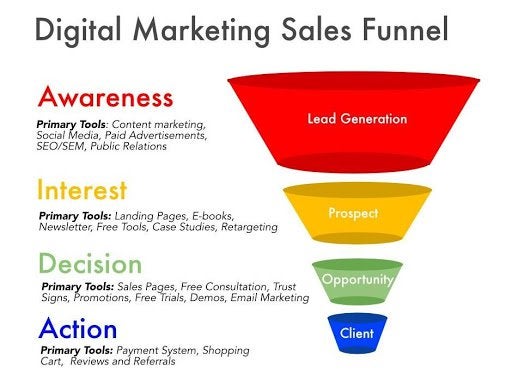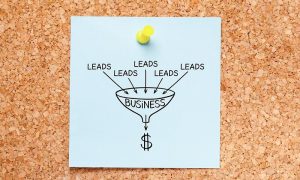Every business wants more qualified leads, but not everyone who visits your website is a potential customer. Your lead generation funnel weeds out window shoppers while providing a seamless experience to all visitors.
Fill your pipeline and improve your sales process by building a high converting sales funnel that moves visitors toward purchase.
Overview: What is a lead generation funnel?
A lead generation funnel is a tool used to move prospects from brand awareness to conversion. It’s also called a customer acquisition funnel, sales funnel, or an e-commerce conversion funnel.
There’s a broad net at the top of the funnel, capturing anyone who visits your website or social profile. Your goal is to turn a visitor into a contact, then use lead scoring to determine where they’re at in your funnel.
To make the process easier, professionals use lead generation software or customer relationship management (CRM) tools to track leads.
The 5 stages of the lead generation funnel
You’ll find different funnels offering three to five stages. Some entrepreneurs focus only on the marketing-to-sales process, whereas others include a phase for post-sale communications. But all funnels are wider at the top and then narrow as you near the decision-making phase.
Plan your funnel by reviewing the basic guidelines for the top of the funnel (TOFU), middle of the funnel (MOFU), and bottom of the funnel (BOFU) stages.

1. Awareness
During the awareness stage, various people come into contact with your brand. They may know nothing about your company, products, or services. Visitors may not even realize they have a problem to solve.
It’s your job to help them and start a conversation. For instance, a person struggling to get a good night’s sleep may search for phrases such as, “Why can’t I fall asleep?,” or, “How can I get better sleep?”
If you’re a mattress company, you know people don’t automatically blame poor sleep on their mattress. Not yet, anyhow. Mattress companies prospect for sales using search engine optimized (SEO) blogs and social media campaigns that grab attention and pull people into their funnel.
2. Interest or consideration
Once people are aware of their problem or your brand, it’s time to nurture them. Turn your visitor into a contact by offering something in return for their email address.
A mattress company may offer a sleep quiz where consumers submit their email address to get the results. From there, the brand sends a series of emails with useful tips for better sleep. People who open the emails may receive a special offer, also called a tripwire, where a company offers the recipient something of value at a low cost.
People tend to get stuck in the consideration phase. Receiving too many emails before they’re ready to buy is a turnoff. They’ll unsubscribe. Still, people are busy, so if you don’t stay at the top of their minds, they’ll move on to something else.
Make decisions about your content and nurturing strategy by looking carefully at each contact’s behavior using a CRM or marketing automation tool. Doing so helps you decide when their actions meet your definition of a marketing qualified lead (MQL).
3. Decision
Once people are aware of their problem and the possible solutions, they start actively looking for answers. At this point, they’re reviewing prices, features, and similar solutions side by side.
Your lead scoring tools place a value on each type of interaction, helping you reach out at the right time. The best timing depends on your typical sales cycle and requires a mix of self-service tools and sales outreach.
4. Action
During the action stage, your leads — who are now sales-qualified leads (SQLs) — have their credit card in hand. You’ve moved them into your CRM software, and they’re ready to buy. Depending on your offering, your sales team may reach out via email or a phone call, or people may simply add items to their online cart.
But your work doesn’t end there. People can still change their minds. Your sales process should lay out specific steps for helping folks through the final stages of the customer journey.
In the case of the mattress business, at this point the consumer knows they need a mattress to sleep better. They’re comparing three top companies — all with similar solutions. Your sales team may reach out and offer to chat online or let them know of an upcoming promotion. Your buyer needs a little push to decide.
5. Follow-up
After your visitor moves from contact to MQL to SQL to a customer, their journey doesn’t end. Your sales team may follow up with an email or phone call. Or your customer may visit your website to track shipping or watch a video about installation.
To generate referrals and good reviews resulting in more leads, it’s essential to support your customers post-purchase.
How to create and use your own lead generation funnel
So how can you create and use your lead generation funnel? The bottom line is that you want to base your funnel, lead scoring, and automation efforts off your target market, behavior, and sales cycle.
1. List all touchpoints
Before you create a sales strategy, you have to figure out how people come across your brand. To get a complete picture of the customer journey, talk to your sales, marketing, and customer support teams.
Write down each current or possible touchpoint, such as:
• Paid media: Pay per click (PPC), out-of-home advertising, social media ads, point-of-sale displays, print mailers, radio, or TV advertisements.
• Owned media: Website, social media pages and posts, blog, retail store, email, mobile apps, text messaging, and landing pages.
• Earned media: Reviews, mentions in third-party articles, word of mouth, and referrals.
2. Define the customer journey
Next, you want to see how people navigate through your touchpoints. Map your customer journey to make sure you’re putting your money and resources into what counts.
Website data like Google Analytics gives you information about bounce or conversion rates, but you’ll need customer feedback to flesh out your customer journey map.
Ask for feedback via interviews or surveys, read reviews, and look at customer service tickets. Find out what your ideal customer feels and wants during each stage of the customer cycle. Then determine how their needs correlate with your funnel.

For example, create a spreadsheet with each stage of your funnel and answer the following questions for each phase:
• How does your potential customer feel?
• What is your prospect or lead thinking about?
• What actions do they take?
• What question is your lead trying to answer?
• Where are they looking for answers?
• What content are they consuming?
Lastly, create definitions for a marketing-qualified lead and a sales-qualified lead. Doing so helps you set up lead scoring in your CRM so leads smoothly pass from marketing to sales.
4. Create content for each phase
Once you have a good idea of your potential customers’ needs, it’s time to create the right content mix to guide them through your sales funnel.
Look at the questions you answered above and develop campaigns that are:
• Platform-specific: Take note of how leads differ based on which channels they use and include content that matches the platform and the customer. For example, you may create a 30-second video about better sleep for Facebook while linking to your 30-minute video on YouTube.
• Content format: Tip sheets and listicles boost brand awareness, whereas detailed spec sheets or comparison guides support the consideration stage. Mix it up using video, infographics, images, and short- or long-form content.
• Prospect needs: Connect each digital asset back to the consumer. Does it answer their questions, and can they find it? Review your campaign’s performance, identify information gaps, and continually adjust your strategy to support your leads.
5. Increase website traffic
Now it’s time to fill your pipeline. Use your customer research to prioritize your marketing mix and balance your wants with your budget. Small business owners generate leads by:
• Posting consistently on social media channels
• Optimizing website content for search engines
• Adding a call-to-action (CTA) to all digital assets
• Targeting local shoppers with print mailers
• Developing a customer review strategy
• Using retargeting ads on Facebook
6. Manage business leads
Managing or qualifying sales leads is vital to your lead generation funnel. Once you’re pulling people into your funnel, you want to make their journey frictionless.
Use your CRM to find out how many people are in your funnel, along with information about lead scores, conversion rates, and potential revenue. Update your contact management system throughout your customer’s lifecycle to perform lead nurturing activities and generate loyalty.
Build a funnel that fills itself
By following your prospects through every stage, including post-purchase, you can increase your word-of-mouth referrals and continually fill your lead generation funnel. Give your target markets what they want and make it easy to find, then use your software tools to qualify and convert leads.
The post How to Use a Lead Generation Funnel to Improve Sales appeared first on The blueprint and is written by Jessica Elliott
Original source: The blueprint






